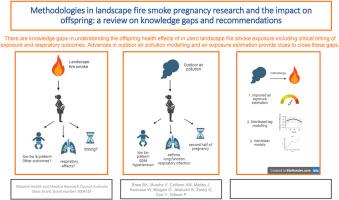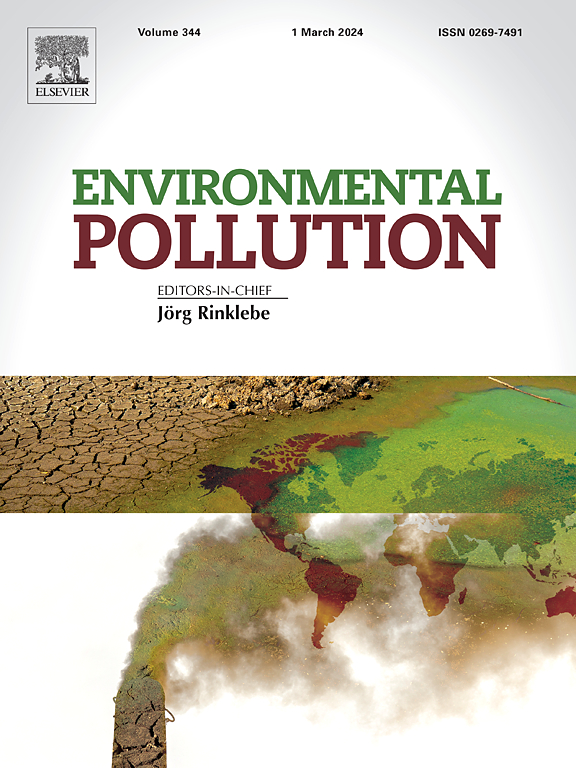景观火灾烟雾妊娠研究方法及其对后代的影响:知识差距与建议综述
IF 7.6
2区 环境科学与生态学
Q1 ENVIRONMENTAL SCIENCES
引用次数: 0
摘要
气候变化导致野火和丛林火灾增加,这意味着包括孕妇及其胎儿在内的更多人将暴露于山火烟雾中。尽管有证据表明,孕妇暴露于山火烟雾会导致出生体重降低、早产和妊娠失败,但目前还缺乏有关其他围产期结果的信息,也缺乏有关儿童后续呼吸系统结果的信息。此外,由于景观火灾烟雾暴露通常是短期(数小时/数天)和间歇性的,迄今为止的知识主要依赖于自然实验和生态学研究,这些研究可能会对暴露进行错误分类并缺乏精确性。另一方面,对妊娠期一般城市室外空气污染暴露及其对围产期和呼吸系统的影响进行了深入研究。特别是,随着空气暴露模型的改进,分析孕期空气污染暴露影响的方法也在不断调整,从而能够确定关键的暴露窗口。在这篇叙述性综述中,我们总结了有关妊娠期景观火灾和直径为 2.5 微米的颗粒物(PM2.5)空气污染暴露对围产期和呼吸系统影响的知识现状,包括对迄今为止的分析方法的评论,以及对如何进一步利用一般空气污染研究中与妊娠期暴露有关的方法进行景观火灾烟雾暴露妊娠期研究的评估。本文章由计算机程序翻译,如有差异,请以英文原文为准。

Approaches in landscape fire smoke pregnancy research and the impact on offspring: a review on knowledge gaps and recommendations
The increase in wildfires and bushfires due to climate change means that more people, including pregnant women and their fetuses will be exposed to landscape fire smoke. Although there is evidence to suggest that pregnancy landscape fire exposure is associated with lower birth weight, preterm birth and pregnancy loss, there is a lack of information on many other perinatal outcomes, as well as information on subsequent respiratory outcomes in children. Furthermore, due to the generally short term (hours/ days) and intermittent nature of landscape fire smoke exposure, the knowledge to date has largely relied on natural experiments and ecological studies which can be subject to misclassification of exposure and a lack of precision. On the other hand, general urban outdoor air pollution exposure during pregnancy and subsequent perinatal and respiratory effects has been well studied. In particular, as air exposure modelling has improved so have the adaptations of methods to analyze the effects of air pollution exposure during pregnancy enabling critical windows of exposure to be identified. In this narrative review we summarize the current state of knowledge about the perinatal and respiratory effects of pregnancy landscape fire and particulate matter <2.5μm in diameter (PM2.5) air pollution exposure, including a comment on analysis methods to date, and an assessment of how methodologies used in general air pollution research in relation to pregnancy exposure can be further harnessed for landscape fire smoke exposure pregnancy research.
求助全文
通过发布文献求助,成功后即可免费获取论文全文。
去求助
来源期刊

Environmental Pollution
环境科学-环境科学
CiteScore
16.00
自引率
6.70%
发文量
2082
审稿时长
2.9 months
期刊介绍:
Environmental Pollution is an international peer-reviewed journal that publishes high-quality research papers and review articles covering all aspects of environmental pollution and its impacts on ecosystems and human health.
Subject areas include, but are not limited to:
• Sources and occurrences of pollutants that are clearly defined and measured in environmental compartments, food and food-related items, and human bodies;
• Interlinks between contaminant exposure and biological, ecological, and human health effects, including those of climate change;
• Contaminants of emerging concerns (including but not limited to antibiotic resistant microorganisms or genes, microplastics/nanoplastics, electronic wastes, light, and noise) and/or their biological, ecological, or human health effects;
• Laboratory and field studies on the remediation/mitigation of environmental pollution via new techniques and with clear links to biological, ecological, or human health effects;
• Modeling of pollution processes, patterns, or trends that is of clear environmental and/or human health interest;
• New techniques that measure and examine environmental occurrences, transport, behavior, and effects of pollutants within the environment or the laboratory, provided that they can be clearly used to address problems within regional or global environmental compartments.
 求助内容:
求助内容: 应助结果提醒方式:
应助结果提醒方式:


